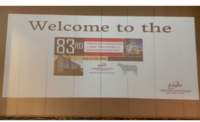Annual Meat Conference 2024
Processors must up their game as labor market favors employees over employers
Employers need to understand what motivates people to come the work for their company.

Photo credit: Fred Wilkinson
Alex Chausovsky, director of analytics and consulting at Bundy Group, and Hinda Mitchell, president and founder of Inspire PR Group, discuss the challenges meat and poultry companies face competing for workers during the Understanding Labor: Where We Are and Where We’re Going workshop at the Annual Meat Conference 2024.
NASHVILLE, Tenn. — The shifting culture of labor and its current dynamics give potential employees more power in the employment decision-making process, and meat and poultry processors need to recognize this shift to attract and retain workers.
During the Understanding Labor: Where We Are and Where We’re Going breakout session at the Annual Meat Conference 2024, presenters Alex Chausovsky, director of analytics and consulting at Bundy Group, and Hinda Mitchell, president and founder of Inspire PR Group, didn't pull any punches in detailing the challenges meat and poultry processors face in the current labor market.
"Competitors doesn't mean the grocery store or the meat plant down the street," Mitchell said, adding that new employers such as tech companies like Intel and Amazon have expanded into new locations and compete for the same workers as meat and poultry processors do while offering attractive pay and a more attractive workplace.
Attracting and retaining workers requires the right approach not just from the human resources department but also top management, Chausovsky said.
"It is the leadership that has the resources and the ability to deploy those resources in order to make the changes that you need to make to be competitive in the labor market today," he said.
Employers need to understand what motivates people to come the work for their company, Chausovsky said.
"Since the pandemic, money — compensation — has been absolutely the key driver of both attraction and retention of talent," he said. "Pre-pandemic, it was actually the direct manager often cited as the No. 1 reason why people left an organization, but today it is competitive pay"
The top five predictors of turnover are:
- pay and benefits are not competitive
- the immediate manager
- poor company culture
- improper fit for the job
- coworkers not committed to doing quality work.
With that in mind, Chausovsky said a vital part of a company's conversation with potential employees is CLAMPS:
- challenge — the job itself, related technology, the market
- location — the ability to work and live where you want
- advancement — career growth and increasing responsibility
- money — overall compensation
- people — both managers and coworkers
- security — the likelihood for long-term employment.
He suggested having interviewees rank these six considerations to help hiring managers gauge what their priorities for job satisfaction are so they can speak to those desires.
Mitchell said surveys suggest nearly half (43%) of employees say a meaningful job is their greatest source of happiness, and 70% say they would leave a company for a position that offers them greater career development and learning opportunities.
"You think you don't need have a line-level worker have a path for advancement? You do," she said.
Mitchell said having a manager who consistently acknowledges employees can reduce turnover by a third.
"Do not underestimate the impact of a manager or supervisor," she said.
Chausovsky and Mitchell suggested steps employers can make to increase their appeal to workers today:
- audit and assess
- make your employer brand shine
- show people like me —outreach needs to speak to employee demographics
- build in values
- reinforce purpose
- make meat and meat cutting the star
- map their career advancement
- communicate and then do more
- drive leadership consistency
- choose to be the employer of choice.
Looking for a reprint of this article?
From high-res PDFs to custom plaques, order your copy today!
.png?height=96&t=1647275041&width=96)





